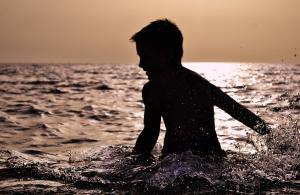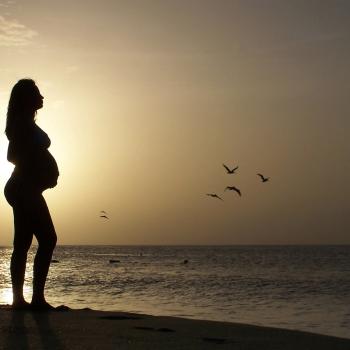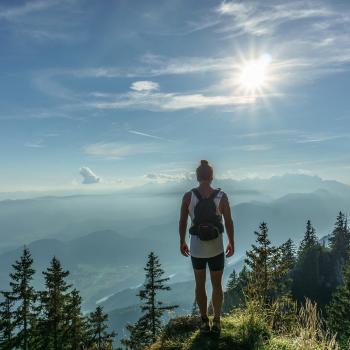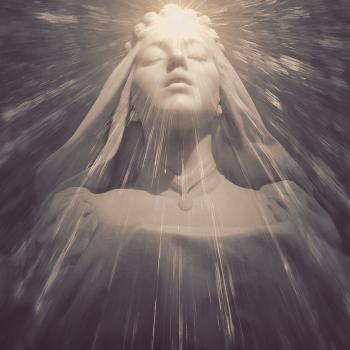Learning to swim as a 5 year old was an enormous challenge for me. The moment my feet could no longer touch the river bottom or swimming pool surface was instantly different. Immediately every part of my body became engaged in staying afloat, legs and arms scissoring in unison, struggling to keep my head above water, where I could breathe the air essential to my living. When we wade into the water, we can measure out our courage, and as long as our feet can touch the bottom, we have no need of faith. We can experience the water, with our feet touching, but it isn’t the “full water experience”. We don’t really “know” the water, what the essence of the water is. We experience it, we can say what it is “like,” we can move in harmony with it, partially aligned with it, but we are less likely to “be” it. So, also, is this the way we encounter God. We can experience God, but God is unknowable. We can experience qualities we know to be god-like, in ourselves and in others. We can experience God’s immanence in Nature. But to really know God, to be authentically ourselves as a manifestation of God – well, that’s a different matter entirely.
Learning to swim
In Louisiana where I grew up, the athletic department of the local university sponsored a swimming program for young children taught by members of the university’s football team. The Olympic size pool literally bubbled with tiny bodies, in a constant litany of above and below water exercises. Children clung noisily to the overhang at the shallow side of the pool. Taking turns we practiced with our instructors, tall, heavily-muscled young men looking, in form and function not unlike welcome ports in a storm, or rocks of Gibraltar, as though they could weight lift several of us simultaneously with each arm. The teachers inspired confidence. With each practice session the teachers moved a few steps further away. This incremental “distancing” was not lost on the children, who wondered at each encounter, whether or not they could “make it.” Each effort, too, had variability – sometimes one would hit a “flow” when all limb and breathing elements seemed to function in unison. Sometimes an effort presented itself as a flailing disaster and one had to be scooped up by the teacher and returned to the side for “a rest” and “a think.”
The goal for the summer was to swim the “long way,” the length of the pool. There was a personalized gold certificate for those who achieved that goal. It wasn’t hard when focusing on the goal, to focus simultaneously on a fear of the “deep end.” For a 5 year old, the “other side” was far, far away, maybe even miles, a dim horizon. And to swim length of the pool, to reach the “other end,” it was necessary to swim through water well over my head.
Physical Water and Spiritual Water
There is a wonderful, old African-American spiritual called “Wade in the Water.” It references both the Israelites, led by Moses, fleeing from Egypt and American slaves, led by the “Holy Ghost” fleeing by way of the Underground Railroad to cross the new “River Jordan” into the land of freedom. I love this song and look forward to it each Lenten season. It stirs something deep inside me – maybe it’s the sonorous notes of the refrain or what seems to be a desperate crying out of the soul for something deeply yearned for. At the very least in the lyrics for both cases above, it is the ostensible need for freedom. But, I believe it speaks to much more, though one might consider that true freedom is synonymous with the purpose of the spiritual journey.
The refrain is particularly interesting:
Wade in the water, children. Wade in the water.
God’s a-going to trouble the water.
This is our first hint that this “water” isn’t just physical water. We’re not just traversing the Red Sea or a swift creek or river currents on the long road north. Our escape is just the beginning – not the whole journey. Nevertheless, we are asked to wade in the water – to get to know the water. As we get to know the water, we will find that it changes from moment to moment. Change is the nature of the water. Water has many faces.
Look over yonder, what do you see?
The Holy Ghost a-coming on me
We have experienced the Holy Ghost, that is, we have experienced a transformational moment of grace. We have awakened to something larger than ourselves, something we have been missing and yearning for, an emptiness physical, sensual life with all its bounty, does not entirely fill. And so the spiritual journey/quest begins for something to fill us, nurture us, and bring us ultimately peace.
And, yet, there is the haunting refrain – at the same time both intriguing and frightening,
Wade in the water, children. Wade in the water.
God’s a-going to trouble the water.
What does it mean that God’s a-going to trouble the water? What does that phrase mean for the spiritual seeker and in what ways does it describe the spiritual journey? Why does God trouble the water?
In the Gospel of Thomas, the reason becomes clearer,
Jesus said, “Those who seek should not stop seeking until they find. When they find, they will be disturbed. When they are disturbed, they will marvel, and will reign over all. [And after they have reigned they will rest.]”
In Thomas, we read Jesus outlining the birth and the journey of the spiritual seeker. We seek an answer to our spiritual loneliness. Jesus says do not stop seeking, until you find. To not seek, one must actively suppress our natural inclination. When we find, we will be disturbed. Things will not be what we expected; life as we “knew” it may fall away. We may lose friends; we may be criticized and become discouraged. We may even lose the feeling of longing that created our journey in the first place. But, with our eyes open, there will be so much more, that we will be amazed at the extraordinary complexity of life and living. There are many “faces” to the spiritual seeker and the journey. Each venturing further, each extension out in our swimming “the long way” to the other end of the pool presents a new face of ourselves and the reality we experience. We eventually develop spiritual “gills” – at once at home in our expanding reality and in the protective hand of God. We are simply awestruck and speechless. From that place of awe, we encounter true peace and joy.
So, why does God trouble the water? To shake us up, to wake us up, to allow us to see what we would be unwilling to look at and work with on our own, were we given the choice.
The spiritual journey is a true journey – we can’t see around the bend, we don’t know the view from the “other side” of the pool, until they get there. We know that each practice run “distances” us a little more from the safety, the known reality, of the shallow side of the pool. We wonder, will we make it? We depend on those who teach us, challenge us, shelter us and comfort us on the way. And, most importantly, we are frightened at times by the depth of the water. What happens when our toes no longer touch. Will we drown?
How deep is the water?
I don’t know the answer to that question. I expect it varies for each of us, in the same way that our deepest personal challenges take different forms for each of us. Universally I believe and from experience I know that the journey requires more than a little courage and faith. It isn’t easy to release ourselves fully into the water, to release ourselves into God – no longer holding back, no tiptoes, no bouncing from foot to foot to stay in contact with the safe ground.
And, I believe, that releasing may not be, in fact, the final step. But, rather, I believe that conscious, joyful immersion is the final step. How difficult is it to experience and to acknowledge how “good” it feels to be in the flow, yet not fear “floating away?”
Perhaps the answer is to simply abide in the flow with a new “ability” to think, speak and act with full consciousness, in full self-realization, fully awake!













